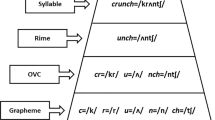Abstract
A series of experiments investigated the role of orthography in the organization of the mental lexicon. A pilot experiment had found no effect of formal overlap between words on a repetition priming task at a lag of 56 intervening items. The first two experiments reported here used a lag of zero and varied SOA. Formal priming was found at SOAs of 1,650 milliseconds and less. However, reducing the proportion of related primes and targets in the experiment reduced formal priming. Moreover, it did so not by affecting response times to formally related primes and targets but by reducing response times to comparison trials in which primes and targets were unrelated. This led to a hypothesis that the formal priming we had observed was only apparent and due to strategic inhibition of responses to unrelated prime-target pairs. The final experiment reduced the proportion of responses to related targets further and examined formal priming at lags of 0, 1, 3, and 10. No formal priming was found under these conditions. Across all experiments, where formal priming occurred, it was due to changes in levels of inhibitory priming in comparison conditions. The conclusion is drawn that convincing evidence for an orthographic or phonological organization of the lexicon is not obtainable using priming procedures.
Similar content being viewed by others
References
Browman, C.P. (1979). Tip of the tongue and slip of the ear: Implications for language processing (Doctoral dissertation, University of California, Los Angeles, 1978).Dissertation Abstracts International, 39, 4213A.
Brown, R., & McNeill, D. (1966). The “tip of the tongue” phenomenon.Journal of Verbal Learning and Verbal Behavior, 5, 325–337.
Clark, H.H. (1973). The language-as-fixed-effect fallacy: A critique of language statistics in psychological research.Journal of Verbal Learning and Verbal Behavior, 12, 335–359.
Dannenbring, G.L., & Briand, K. (1982). Semantic priming and the word repetition effect in a lexical decision task.Canadian Journal of Psychology, 36, 435–444.
Davelaar, E., & Coltheart, M. (1975). Effects of interpolated items on the association effect in lexical decision tasks.Bulletin of the Psychonomic Society, 6, 269–272.
deGroot, A.M.B. (1984). Primed lexical decision: Combined effects of the proportion of related prime-target pairs and the stimulus-onset asynchrony of prime and target.Quarterly Journal of Experimental Psychology, 36A, 253–280.
deGroot, A.M.B., Thomassen, A.J.W.M., & Hudson, P.T.W. (1982). Associative facilitation of word recognition as measured from a neutral prime.Memory and Cognition, 10, 358–370.
Dell, G.S. (1981). Phonological and lexical encoding in speech production: An analysis of naturally occurring and experimentally elicited speech errors (Doctoral dissertation, University of Toronto, 1980).Dissertation Abstracts International, 42, 353B.
Dell, G.S. (1986). A spreading activation theory of retrieval in sentence production.Psychological Review, 93, 283–321.
Dell, G.S., & Reich, P.A. (1981). Stages in sentence production: An analysis of speech error data.Journal of Verbal Learning and Verbal Behavior, 20, 611–629.
Fay, D., & Cutler, A. (1977). Malapropisms and the structure of the mental lexicon.Linguistic Inquiry, 8, 505–520.
Fowler, C.A., Napps, S.E., & Feldman, L.B. (1985). Lexical entries are shared by regular and irregular, morphologically-related words.Memory and Cognition, 13, 241–255.
Glushko, R.J. (1979). The organization and activation of orthographic knowledge in reading aloud.Journal of Experimental Psychology: Human Perception and Performance, 5, 674–691.
Gough, P.B., Alford, J.A., Jr., & Holley-Wilcox, P. (1981). Words and contexts. In O.J.L. Tzeng & H. Singer (Eds.),Perception of print: Reading research in experimental psychology (pp. 85–102). Hillsdale, New Jersey: Erlbaum.
Henderson, L., Wallis, J., & Knight, D. (1984). Morphemic structure and lexical access. In H. Bouma & G. Bouwhis (Eds.),Attention and performance (Vol. 10) Hillsdale, New Jersey: Erlbaum.
Kempley, S.T., & Morton, J. (1982). The effects of priming with regularly and irregularly related words in auditory word recognition.British Journal of Psychology, 73, 441–454.
Kucera, H. & Francis, W. (1967).Computational analysis of present-day American English. Providence: Brown University Press.
McClelland, J.L., & Rumelhart, D.E. (1981). An interactive activation model of context effects in letter perception: Part 1. An account of basic findings.Psychological Review, 88, 375–407.
Meyer, D.E., Schvaneveldt, R.W., & Ruddy, M.G. (1972, November).Activation of lexical memory. Paper presented at the meeting of the Psychonomic Society, St. Louis, Missouri.
Morton, J. (1969). Interaction of information in word recognition.Psychological Review, 76, 165–178.
Morton, J. (1981). The status of information processing models of language. In H. Longuet-Higgins, J. Lyons, & D. Broadbent (Eds.),The psychological mechanisms of language. London: The Royal Society and the British Association.
Murrell, G.A., & Morton, J. (1974). Word recognition and morphemic structure.Journal of Experimental Psychology, 102, 963–968.
Stanners, R.F., Neiser, J.J., Hernon, W.P., & Hall, R. (1979). Memory representation for morphologically related words.Journal of Verbal Learning and Verbal Behavior, 18, 399–412.
Stemberger, P.A. (1983). The lexicon in a model of language production (Doctoral dissertation, University of California, San Diego, 1982).Dissertation Abstracts International, 43, 791A.
Tweedy, J.R., Lapinski, R.H., & Schvaneveldt, R.W. (1977). Semantic-context effects on word recognition: Influence of varying the proportion of items presented in an appropriate context.Memory and Cognition, 5, 84–89.
Author information
Authors and Affiliations
Additional information
This research was supported by NIH Grant HD 01994 to Haskins Laboratories
Rights and permissions
About this article
Cite this article
Napps, S.E., Fowler, C.A. Formal relationships among words and the organization of the mental lexicon. J Psycholinguist Res 16, 257–272 (1987). https://doi.org/10.1007/BF01067546
Accepted:
Issue Date:
DOI: https://doi.org/10.1007/BF01067546




